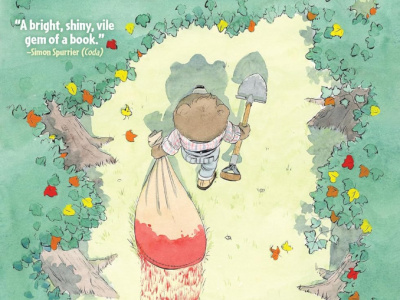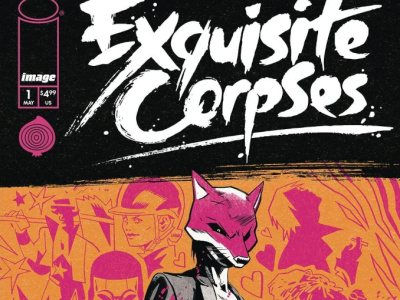 ICv2 caught up with Dark Horse Manga Editor Carl Horn to talk about the North American manga market and Dark Horse’s place in it. In Part 2, we talk about selling manga titles that don’t have tie-ins, and went on to Dark Horse’s plans for 2014. In Part 1, we talked about the manga market past and present, and where Dark Horse saw strength in 2013.
ICv2 caught up with Dark Horse Manga Editor Carl Horn to talk about the North American manga market and Dark Horse’s place in it. In Part 2, we talk about selling manga titles that don’t have tie-ins, and went on to Dark Horse’s plans for 2014. In Part 1, we talked about the manga market past and present, and where Dark Horse saw strength in 2013. Any other observations on the market?
We have a series we’ve been running for a long time called The Kurosagi Corpse Delivery Service, which has gotten some critical acclaim but sold very poorly. This to me illustrates one of the difficulties with selling manga. Gantz and Evangelion have anime spin-offs and Gantz has a live action spin-off. That’s true of many manga that are on the U.S. market. Mobile Suit Gundam has been successful for Vertical, for example, and Gundam is one of the most famous anime series of all time.
But if you have a manga like Kurosagi Corpse Delivery Service, for which there is no anime no tie-in of any sort, I believe it’s more difficult. That’s when you’re getting into the realm of pure manga. I don’t necessarily mean “pure” in a creative sense, but it illustrates the difficulty of selling just manga rather than manga that is part of some larger program.
It also speaks well of a manga, that it gets adapted into an anime, or live action because people believe it has additional potential in those media.
Of course if it doesn’t get adapted, sometimes it’s not necessarily that the manga itself is bad, it’s just that people are having difficulty seeing how it could work in another format. In some cases maybe it’s too good a manga in that respect, because the idea is too finely tuned for any other format; it’s ideally expressed in manga, but difficult to express as a TV show.
That’s very frustrating to me. We’re also about to introduce another volume in a series called Eden. Eden is exactly the same case. It’s an excellent, superb manga, but it has no tie-ins, no anime of any sort, and it sells very poorly.
People sometimes ask me, “What ever happened to the great science fiction manga like Akira or Ghost in the Shell?” And I say, “Check out Eden. If you want something like that, that’s where it is.”
But there’s no anime.
Part of my job as an editor is to think about the things that are low-selling as well as the reasons they’re high-selling. There as much a part of my responsibilities as things which are runaway successes. I don’t need to tell anyone what Final Fantasy is, they all know it already, but it might be challenge to explain the merits of Kurosagi or Eden, if they’ve never heard of it.
Eden has had 14 volumes and Kurosagi has had 13 volumes released. If you only release a few volumes of series like that, you can make it profitable. You’ll still be in the black on a few volumes, but if you keep going, most series get gradual sales declines, and eventually the entire project gets into the red. So you start to lose money on the entire thing. There’s only so far you can go with that as a publisher. You can lose money for a little while if you really care about the book and it’s high quality, but after a while it gets to be a little ridiculous. You can do things like space out the releases so you don’t lose too much blood at one time, but that’s also a difficult way to keep readers’ attention.
I articulate these things because they illustrate one aspect of the ongoing challenges that I face. I won’t be satisfied as a manga editor until I can find ways to make books like that more successful. We’re hoping that with our new relationship with Random House that we’ll be able to reach a wider audience.
We think of strategies like combining volumes as an omnibus, for example. Or, there things that Viz has done, for example with Bakuman, where they have released entire series as boxed sets. (That can be a problem though, suppose your printing numbers are wildly different on different volumes. You go to the warehouse and have 300 copies of one volume and 1800 copies of another and you need all the same number in order to do a boxed set.) We think about those things. We try to think “what can we do with this?”
We also want to continue to release a balance of different types of manga titles. By balance, I mean old favorites, titles that reflect what people are talking about right now, like Oreimo was a good example of that last year. It was also a success for us. And also titles that are more experimental or perhaps more creator-oriented. It’s the same kind of balance we try to seek with our comics in general.
What are the releases you think have the greatest chance for commercial success this year?
Our bestselling manga of all time is still Lone Wolf and Cub. And this year we are releasing the long-awaited sequel to that, New Lone Wolf and Cub. It’s an 11-volume series, by the same writer, Kazuo Koike with a different artist of course, because Goseki Kojima passed away some years ago.
Lone Wolf and Cub ends with a very dramatic duel between Itto Ogami and the head of the Yagyu clan, which his son Daigoro witnesses. The New Lone Wolf and Cub picks up exactly where the last one ended, except that it kicks off with a twist beginning. In addition to that, Daigoro is a little kid, what’s he going to do now? Who’s going to be his companion?
A new fellow shows up, a samurai, who is from Satsuma province. And anyone who knows their Japanese history knows that Satsuma was a famous rebellious thorn in the side of the Shogunate, and in the 19th Century eventually played a major role in overthrowing them. To say someone is from Satsuma in a story about the samurai days is synonymous with saying that conspiracies and intrigue are going on. Once again you have this little boy caught up in these political intrigues, not to mention the vicious bloodshed of the period.
The manga is translated by Dana Lewis, who is the translator of the original work. As with the original series, there will be a lot of notes to let you know about the various terms of the period. Part of the reason that Lone Wolf and Cub is such a great series (and the new series definitely has these qualities), is that not only was it an epic journey of action and adventure, but also a journey through a different time and a different place. The stories often hinge on the strange customs of the period, or the political secrets, or the particular techniques of the school. Or even small scale details like how things are cooked or how people crossed rivers. It’s like this richly developed fantasy world except it’s not fantasy, it’s a real place and he takes you into all that. I’m looking forward to that.
Another series that we think will get a lot of attention is kind of the complete opposite of New Lone Wolf and Cub; it’s our Hatsune Miku manga. It’s an omnibus called Unofficial Hatsune Mix.
Anybody who has been to a convention in recent years has seen people cosplaying as a girl with long, green ponytails reaching down almost to the floor. This character is Hatsune Miku who is a vocaloid, which is a form of speech software developed by a company called Crypton on Hokkaido, Japan for the Yamaha Corporation. Just as a regular synthesizer enables you to do instrumental music, a vocaloid allows you to synthesize singing and vocals. With this people can write their own songs. Miku is this kind of idol singer character who will sing them for you, so it puts a face and a character to the voice. They sampled a real singer and broke her voice down into all the component parts, so they can have her sing whatever you compose. She’s one of the vocaloids. She has other friends who are other characters like that.
How many volumes is that series and when is it coming out?
The on sale date is July 2nd. It was originally three volumes in Japan, we’re combining it into one omnibus.
Other key launches for 2014?
Another release we’re putting a lot of attention to is the Dragon Girl and Monkey King: The Art of Katsuya Terada. That’s our art book coming out. Terada was nominated for an Eisner last year as best painter and illustrator. This is a 200-page art book with an introduction by Guillermo del Toro, who’s a big fan of his.
Basically it takes you inside all his works as a commercial illustrator and gives you a guided tour of the state of illustration in Japan. We take you to all the publishing houses, to all the video games, all the exhibitions. What does it mean to be a commercial illustrator in Japan? Who do you work for? What kinds of things do you do?
As a comic company we always want to work directly with the creators, which isn’t always easy with the Japanese creators. In Terada’s case, he’s somebody we know and are trying to make the most of this possibility and be Terada’s ambassador in the U.S. That is coming out July 23.
Any other big releases?
We are going to be announcing new titles at Sakura-Con in April in Seattle.
Click here to go back to Part 1.







